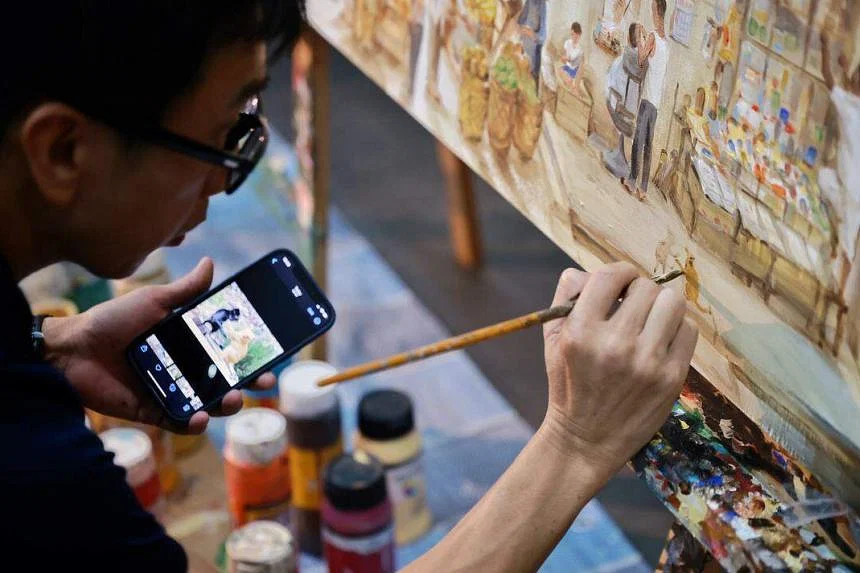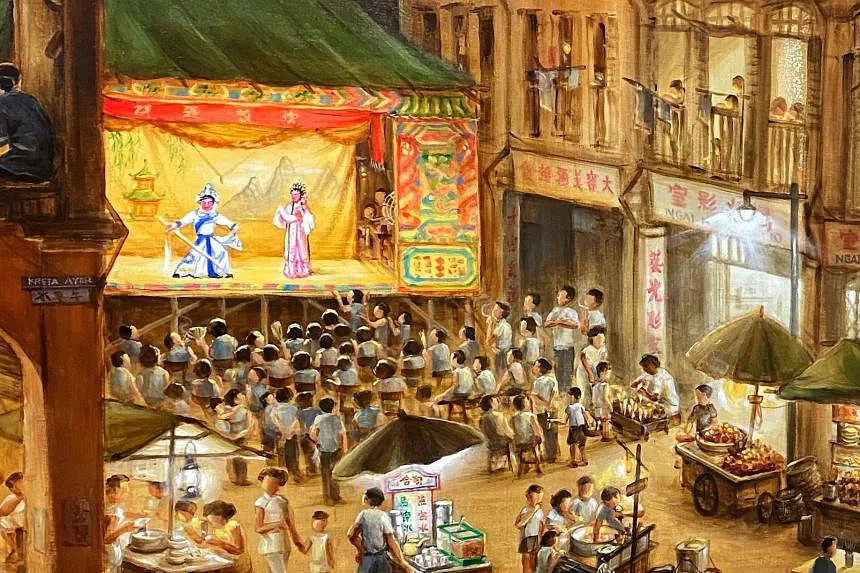January 16, 2023
SINGAPORE – With a few dabs of his paintbrush on canvas, artist Yip Yew Chong on Sunday afternoon applied the finishing touch to a work portraying scenes in Singapore.
About 30 people gathered at Tiong Bahru Community Centre to watch him complete the painting that had been 18 months in the making.
Spanning 60m – similar in length to five double-decker buses lined up head to tail – the work is by far the 54-year-old’s longest, in sheer length and the time taken for completion.
The entire painting, which has not been named, will be exhibited later this year at a venue that Mr Yip will disclose when it is confirmed.
Mr Yip is well known for his heritage murals in neighbourhoods such as Tiong Bahru, Kampong Glam and Chinatown.
Across 27 canvas panels, his latest work captures everyday Singapore in the 1970s and 1980s, ranging from a bustling Change Alley in Raffles Place, where money changers and souvenir shops once dominated, to a bunk in Pulau Tekong’s Basic Military Training Camp 1, where recruits were made to “stand by bed” – an informal term referring to bunk inspections.
Mr Yip began work on the first panel in August 2021, and, between then and Sunday, also took on other projects.
The final scene he painted on Sunday was a pair of lion dancers and a martial artist practising on the rooftop of Kong Chow Wui Koon, a clan association in New Bridge Road.
He said he was inspired to start on the work by a friend who had urged him to create a Singapore-style historical Chinese scroll, adding that he aimed for it to be something the public could relate to and discuss.
Scenes and settings were inspired by a mix of Mr Yip’s imagination, memories and research, said the former accountant, who became a full-time artist in 2018. “The scenes are representative and thus fictional, emphasising storytelling over historical accuracy,” he said in an Instagram post in October 2021 that explained the rationale behind his project.
In many of the panels, Mr Yip painted buildings with their walls absent, allowing viewers to peer into the spaces such as a Housing Board flat where a group had gathered to watch the Malaysia Cup on television, or Old Parliament House when a parliamentary sitting was under way.
He told The Straits Times on Sunday that he had chosen to depict the 1970s and 1980s because that was when he was growing up, as well as when Singapore was transforming rapidly.
“The old and the new coexisted during these two decades,” he said.
Pointing to the first panel of the project, which portrays Chinatown’s shophouses and streets at night, he said: “In the 60s, you only see kampungs and old shophouses like these, but you don’t see many tall buildings. In the 90s, all these disappeared – the facades may still be there, but the lifestyles and the residents are no longer there.”
He added that he has a connection with all the scenes he painted.
The first and last panels, showing Chinatown in the day and at night, capture his family’s second-storey home where he lived for 14 years before it was demolished.
“I intended to make the first and the last panels transition into each other to complete a full circle,” said the artist, adding that the entire work, when on display, will likely be a semicircle.

Mural artist Yip Yew Chong said that he had chosen to depict the 1970s and 1980s as those were the years when he was growing up, as well as when Singapore was transforming rapidly. ST PHOTO: JASON QUAH
Besides the two panels of Chinatown, one showing Tiong Bahru was on display on Sunday at the community centre.
Having painted the first 26 panels at home or in a studio, he decided to finish the project with a live audience as it felt like he was completing a marathon. “When you get to the finish line, you will see lines of people cheering you on – that’s the feeling today,” he said.
Housewife Sayumi Matsubara, 43, and her 10-year-old daughter Mikasa were among the first guests to arrive when Mr Yip started painting just after noon on the final day of his project.
Ms Matsubara said they made a last-minute decision to drop by Tiong Bahru when they found out through social media that Mr Yip was painting live, and added that Mikasa is a fan of his art, having seen Mr Yip’s murals at various locations in Singapore. The mother and daughter took photos with Mr Yip, who left Mikasa a note and an autograph in her sketchbook.

The entire painting, which has not been named, will be exhibited later this year at a venue that Mr Yip will disclose when confirmed. ST PHOTO: JASON QUAH
Mikasa, who loves drawing manga characters and moved to Singapore from Osaka, Japan, a year ago, said she enjoys Mr Yip’s work “as it makes me wonder about how things were in Singapore in the past”.
Retiree Steven Phua, who looked on as Mr Yip finished his painting, said the artist’s work “brings back memories of childhood days”.
“His paintings and murals are very vivid, and it is something I prefer over digital art, which I find is not in touch with reality,” said the 69-year-old, who used to work in the aviation industry.
He added that the work reminded him of the years he spent as a child living in a Joo Chiat shophouse above a provision shop that his father owned.
“Mr Yip puts his heart and soul into painting, and brings olden days to life. Without efforts like these, we cannot see such scenes any more.”

Scenes and settings on the painting were inspired by a mixture of Mr Yip Yew Chong’s imagination, memories and research. ST PHOTO: JASON QUAH

Across 27 canvas panels, Mr Yip Yew Chong’s work captures everyday Singapore in the 1970s and 1980s. ST PHOTO: JASON QUAH


